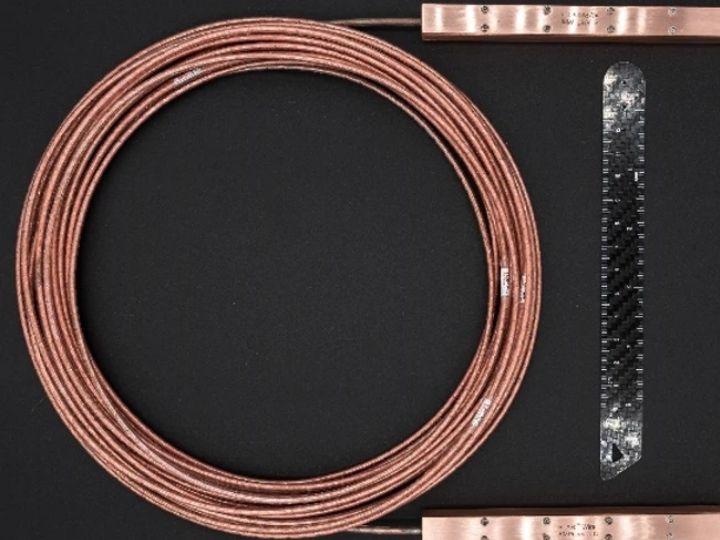Superconductivity causes the disappearance of electrical resistance and it is a technology that both powers science and puzzles researchers.
 STAR – Symmetric Tape Round–superconductor wires are the only superconductor wires available today with a diameter of just 1–2 mm, bend radius capability of 15 mm, and high critical currents over a wide range of temperatures from 4.2 K to 77 K. Image Credit: University of Houston.
STAR – Symmetric Tape Round–superconductor wires are the only superconductor wires available today with a diameter of just 1–2 mm, bend radius capability of 15 mm, and high critical currents over a wide range of temperatures from 4.2 K to 77 K. Image Credit: University of Houston.
The phenomenon powers MRI scanners and facilitates new drug discovery using the latest spectroscopy machines. It is used to make strong magnets that help crush atoms as researchers strive to reveal how the universe is created and how it functions.
Amidst all this and more diverse uses, the next-generation machines could feature one common link — the type of special wire, or superconducting material, essential to power the development of ultra-high field magnets that require hardly any power for lasting operation.
It is a unique wire that can only be made by Venkat Selvamanickam, M.D. Anderson Chair Professor of Mechanical Engineering at the University of Houston Cullen College of Engineering and director of the Advanced Manufacturing Institute.
The high-temperature superconducting wires developed by him have the potential to carry around 300 to 600 times the current carrying capacity of copper wires of a similar size.
Selvamanickam owns a company named AMPeers, short for Advanced Materials Pioneers, in collaboration with the University of Houston (UH) and has received three grants summing $1.6 million (two from the Department of Energy and one from the U.S. Navy) to expedite the technology’s utilization.
These grants have been received from the Small Business Innovation Research (SBIR) and Small Business Technology Transfer (STTR) programs, which encourage domestic small businesses to take part in federal research with the prospects for commercialization.
AMPeers is scaling up UH-developed superconductor technologies to manufacturing and commercialization and these awards will help reach our goals faster.
Venkat Selvamanickam, Anderson Chair Professor of Mechanical Engineering, University of Houston
Dubbed Symmetric Tape Round, or STAR, the superconductor wires are the only ones that come with a diameter of just 1 to 2 mm, bend radius capability of 15 mm and high current-carrying capacity across an extensive range of temperatures varying from 4.2 to 77 K.
It is not possible to bend other round-shaped superconductor wires to such small diameters or use them at temperatures much greater than 4.2 K. Therefore, several applications are viable with a wider operating temperature range.
The STAR wires’ empowering technology is a special superconductor symmetric tape technology designed by AMPeers and UH. The tape is known as RE-Ba-Cu-O (REBCO, RE = rare earth) superconductor film.
It is possible to bend symmetric REBCO tapes to 0.8 mm in diameter while still retaining beyond 95% of their current carrying capacity. By contrast, normal REBCO tapes tend to degrade even below 6 mm bend diameter. Such excellent bendability paves the way for robust, yet compact magnets.
In our phase-one work, we reduced the cost of the wire. Now, in phase two, with $1.15 million from the DOE, we will work to scale up our manufacturing of the low-cost wire and also make the wires longer. The second grant, $200,000 also from the DOE, will be used to develop multi-strand cables with these wires.
Venkat Selvamanickam, Anderson Chair Professor of Mechanical Engineering, University of Houston
Navy makes use of the REBCO wires to ensure high power density that fulfills the requirements of their latest power systems. Selvamanickam and the company will decipher the kinks or hot spots that can take place when such high current densities are endured. Removal of such hot spots is essential to evade the detrimental collapse of the superconducting device.
While long tapes with uniform current-carrying capability are highly desirable to avoid such hot spots, methods to manage local defects in REBCO tapes have to be developed since that is lot more practical.
Venkat Selvamanickam, Anderson Chair Professor of Mechanical Engineering, University of Houston
The three grants received from the DOE’s High Energy Physics office and the Navy brings to six the number of grants AMPeers has obtained from them in the last five years as the startup started to scale up UH-developed technologies to manufacturing and commercialization.